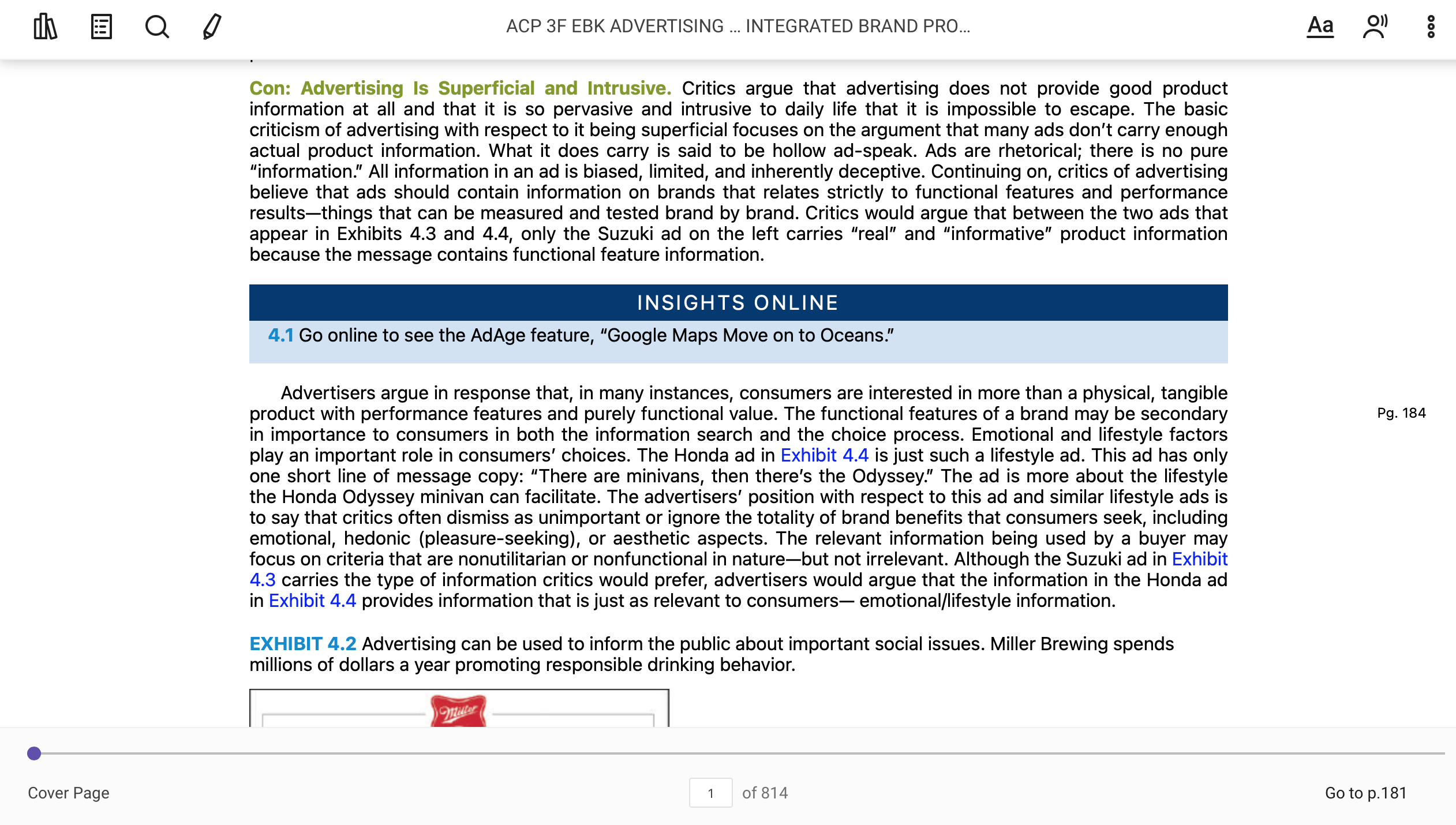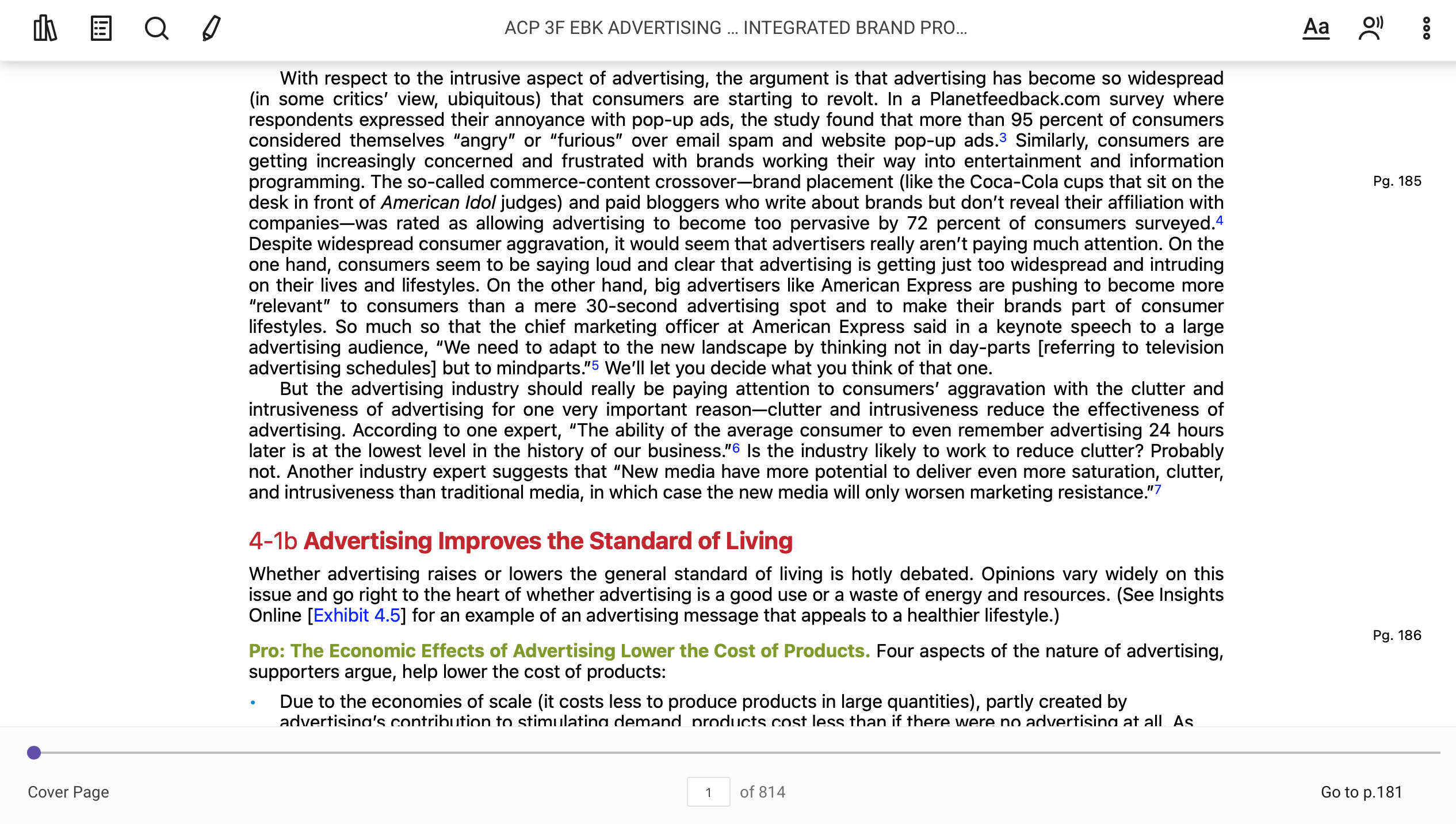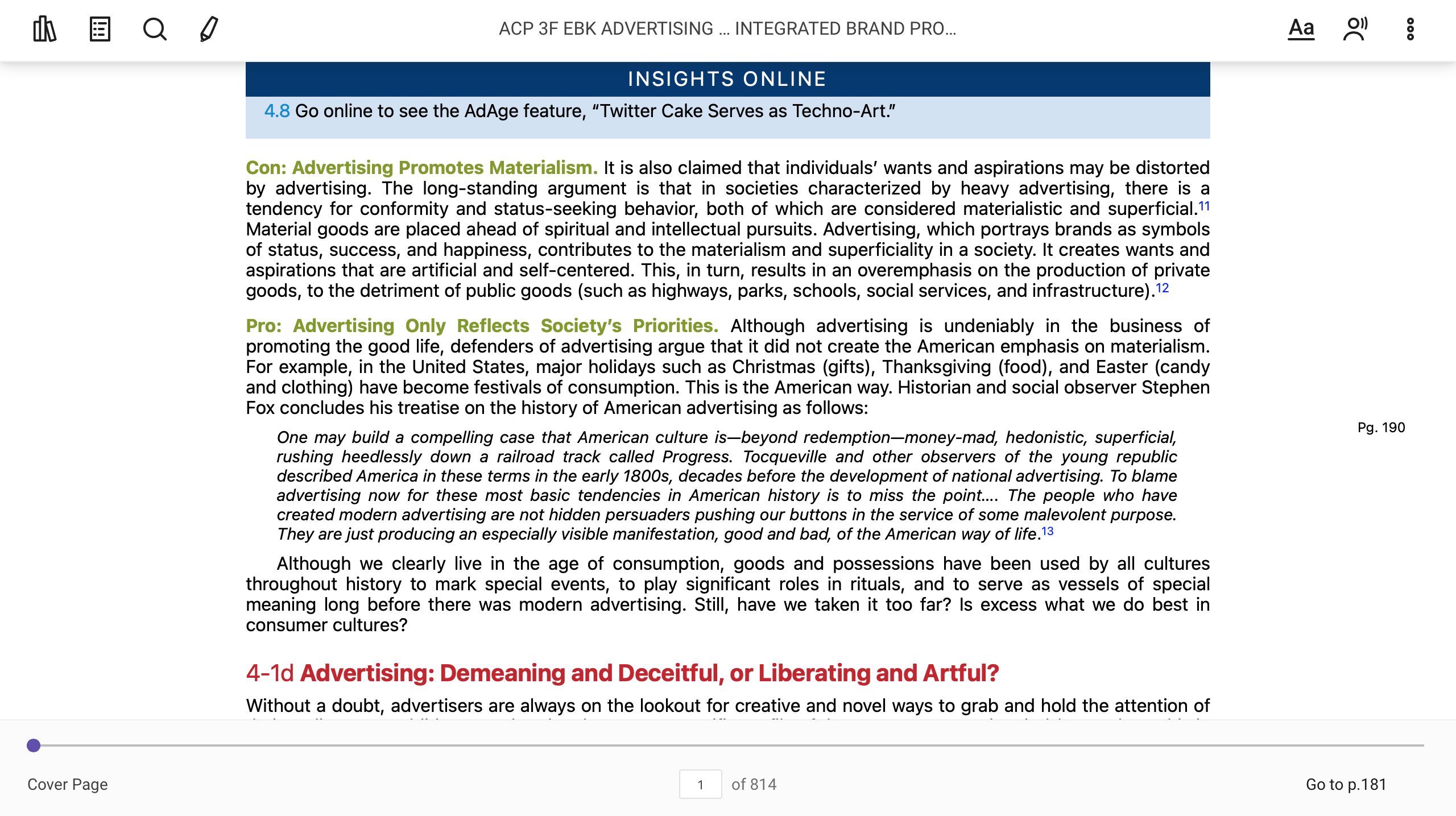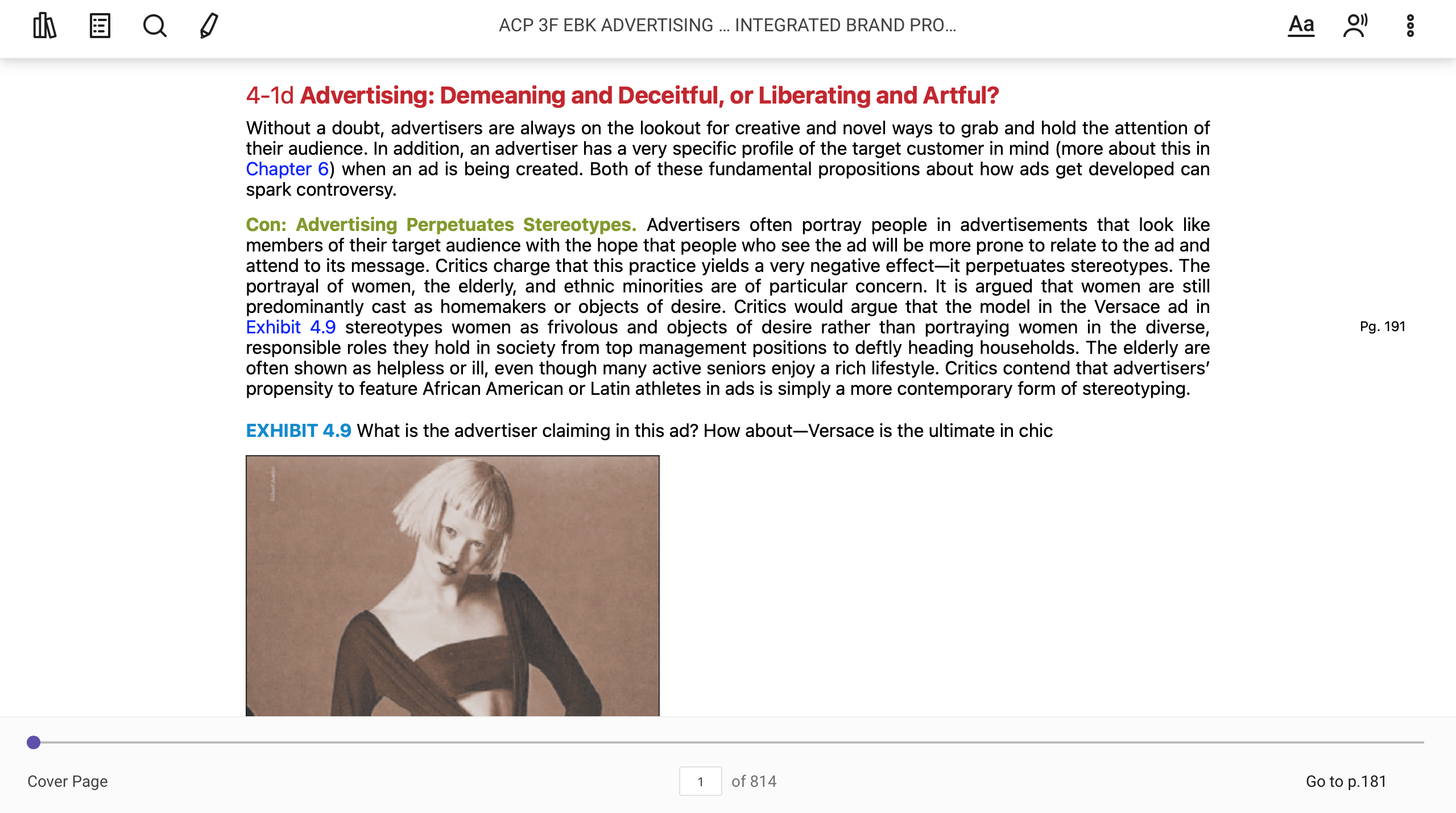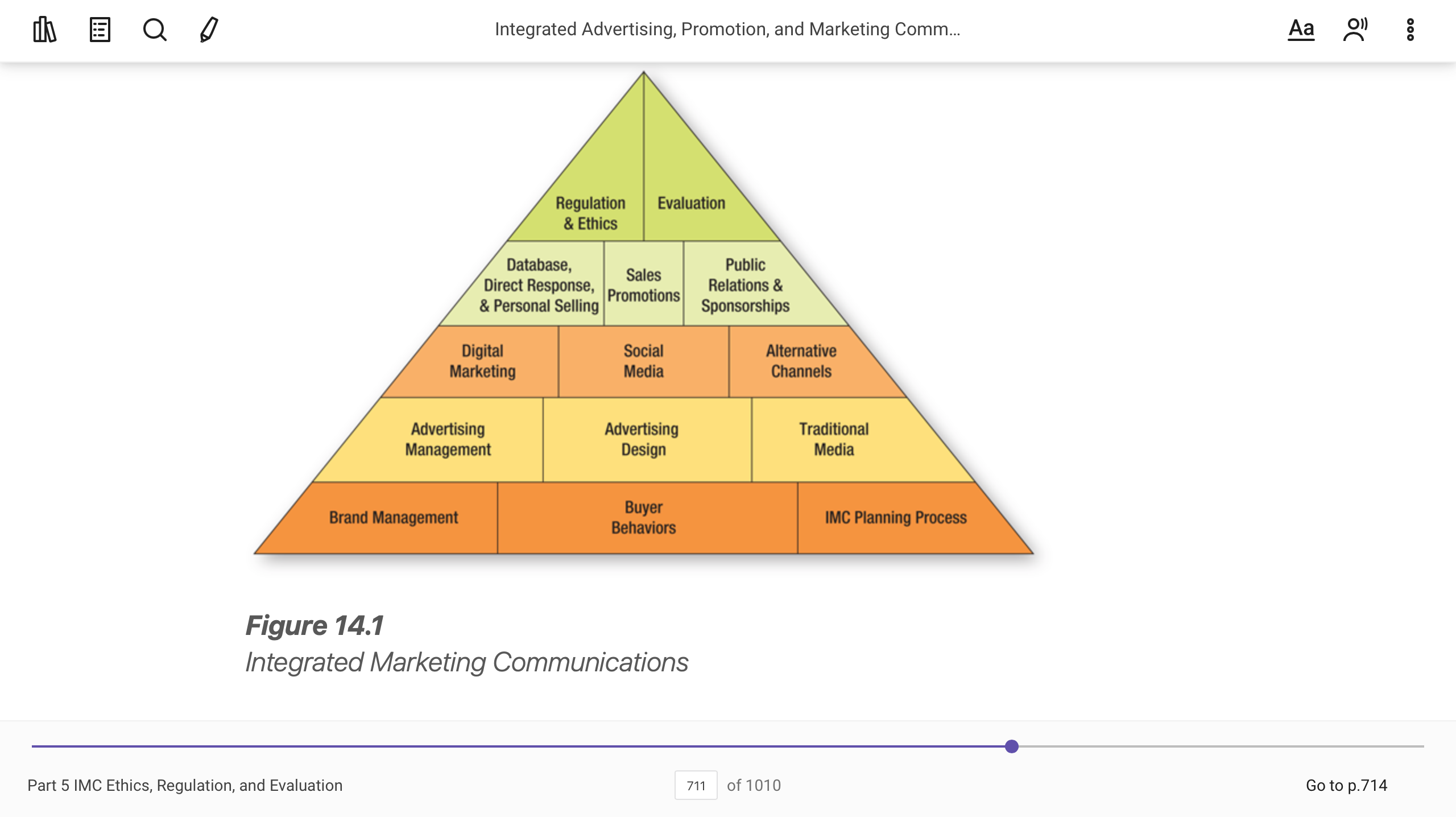ReviewCh. 4 ofAdvertising and Integrated Brand Promotionand reflect on the pros and cons for each social aspect of advertising.
ReviewFigure 14.1 on p. 384 (Ch. 14) ofIntegrated Advertising, Promotion, and Marketing Communicationsfor an overview of integrated marketing communications.
Address at least three of the following social aspects and discuss your own stance.
- Advertising educates consumers
- Advertising improves the standard of living
- Advertising affects happiness and general well-being
- Advertising: demeaning and deceitful or liberating and artful
- Advertising has a powerful effect on the mass media
Includewhere you think ethical considerations can come into play as you develop and execute a sales and marketing plan. Include your thoughts about truth in advertising, advertising controversial products, and regulations.
[m Q g ACP 3F EBK ADVERTISING INTEGRATED BRAND PRO... Aa g) 4-1 THE SOCIAL ASPECTS OF ADVERTISING The social aspects of advertising are often volatile. For those who feel that advertising is intrusive, crass, and manipulative, the social aspects usually provide the most fuel for heated debate. We can consider the social aspects of advertising in several broad areas that highlight both the positive and negative social aspects of advertising. On the positive side, we'll consider advertising's effect on consumers' knowledge, standard of living, and feelings of happiness and well-being, and its potential positive effects on media. On the negative side, we'll examine a variety of social criticisms of advertising, ranging from the charge that P9182 advertising wastes resources and promotes materialism to the argument that advertising perpetuates stereotypes. Our approach is to offer the pros and cons on several issues about which critics and advertisers commonly argue. Be forewarnedthese are matters of opinion, with no clear right and wrong answers. You will have to draw your own conclusions. But above all, be analytical and thoughtful. These are important issues and without understanding and contemplating these issues, you really haven't studied advertising and promotion at all. 4-1a Advertising Educates Consumers Does advertising provide valuable information to consumers, or does it seek only to confuse or entice them? Here's what the experts on both sides have to say. Pro: Advertising Informs. Supporters of advertising argue that advertising educates consumers, equipping them with the information they need to make informed purchase decisions. By regularly assessing information and advertising claims, consumers become more educated regarding the features, benefits, functions, and value of products. Further, consumers can become more aware of their own tendencies toward being persuaded by certain types of product information. Historically, the very positive position has been offered that advertising is "clearly an immensely powerful instrument for the elimination of ignorance!\" (See Insights Online [Exhibit 4.1] for an interesting example.) Now, that might be a little bit overstated, but according to this argument, better-educated consumers enhance their lifestyles and economic power through astute marketplace decision makingcan't argue with that! A related argument is that advertising reduces product search timethat is, the amount of time an individual spends to search for desired products and services is reduced because of advertising, access to the Web, and mobile messages from advertisers. The large amount of information readily available through advertising and websites allows consumers to easily assess information about the potential value of brands without spending time A.\"- .1'...' L__.._IE.._. 1...... \"Leg: 4.... as .._._u .LA... Ln\"... A- \"Ain't; .A-.. \"A. -u--__ :.Ax_..__-x:_.a -_._LA:._AA. 2\" \"A nnnnn . Cover Page 1 of 814 Go to p.181 [m Q g ACP 3F EBK ADVERTISING INTEGRATED BRAND PRO... Aa 2! Con: Advertising Is Superficial and Intrusive. Critics argue that advertising does not provide good product information at all and that it is so pervasive and intrusive to daily life that it is impossible to escape. The basic criticism of advertising with respect to it being superficial focuses on the argument that many ads don't carry enough actual product information. What it does carry is said to be hollow ad-speak. Ads are rhetorical; there is no pure \"information." All information in an ad is biased, limited, and inherently deceptive. Continuing on, critics of advertising believe that ads should contain information on brands that relates strictly to functional features and performance resultsthings that can be measured and tested brand by brand. Critics would argue that between the two ads that appear in Exhibits 4.3 and 4.4, only the Suzuki ad on the left carries "real" and "informative" product information because the message contains functional feature information. INSIGHTS ONLINE 4.1 Go online to see the AdAge feature, "Google Maps Move on to Oceans." Advertisers argue in response that, in many instances, consumers are interested in more than a physical, tangible product with performance features and purely functional value. The functional features of a brand may be secondary Pa 184 in importance to consumers in both the information search and the choice process. Emotional and lifestyle factors play an important role in consumers' choices. The Honda ad in Exhibit 4.4 is just such a lifestyle ad. This ad has only one short line of message copy: "There are minivans, then there's the Odyssey." The ad is more about the lifestyle the Honda Odyssey minivan can facilitate. The advertisers' position with respect to this ad and similar lifestyle ads is to say that critics often dismiss as unimportant or ignore the totality of brand benefits that consumers seek, including emotional, hedonic (pleasure-seeking), or aesthetic aspects. The relevant information being used by a buyer may focus on criteria that are nonutilitarian or nonfunctional in naturebut not irrelevant. Although the Suzuki ad in Exhibit 4.3 carries the type of information critics would prefer, advertisers would argue that the information in the Honda ad in Exhibit 4.4 provides information that is just as relevant to consumers emotional/lifestyle information. EXHIBIT 4.2 Advertising can be used to inform the public about important social issues. Miller Brewing spends millions of dollars a year promoting responsible drinking behavior. . Cover Page 'I of 814 Go to p.181 [m Q j ACP 3F EBK ADVERTISING INTEGRATED BRAND PRO... Aa ,0") With respect to the intrusive aspect of advertising, the argument is that advertising has become so widespread (in some critics' view, ubiquitous) that consumers are starting to revolt. In a Planetfeedbackcom survey where respondents expressed their annoyance with pop-up ads, the study found that more than 95 percent of consumers considered themselves "angry" or "furious" over email spam and website pop-up ads.3 Similarly, consumers are getting increasingly concerned and frustrated with brands working their way into entertainment and information programming. The so-called commercecontent crossoverbrand placement (like the Coca-Cola cups that sit on the P9. 185 desk in front of American Idol judges) and paid bloggers who write about brands but don't reveal their affiliation with companieswas rated as allowing advertising to become too pervasive by 72 percent of consumers surveyed.4 Despite widespread consumer aggravation, it would seem that advertisers really aren't paying much attention. On the one hand, consumers seem to be saying loud and clear that advertising is getting just too widespread and intruding on their lives and lifestyles. 0n the other hand, big advertisers like American Express are pushing to become more \"relevant" to consumers than a mere 30-second advertising spot and to make their brands part of consumer lifestyles. So much so that the chief marketing officer at American Express said in a keynote speech to a large advertising audience, "We need to adapt to the new landscape by thinking not in day-parts [referring to television advertising schedules] but to mindparts."5 We'll let you decide what you think of that one. But the advertising industry should really be paying attention to consumers' aggravation with the clutter and intrusiveness of advertising for one very important reasonclutter and intrusiveness reduce the effectiveness of advertising. According to one expert, "The ability of the average consumer to even remember advertising 24 hours later is at the lowest level in the history of our business."6 Is the industry likely to work to reduce clutter? Probably not. Another industry expert suggests that "New media have more potential to deliver even more saturation, clutter, and intrusiveness than traditional media, in which case the new media will only worsen marketing resistance."7 41b Advertising Improves the Standard of Living Whether advertising raises or lowers the general standard of living is hotly debated. Opinions vary widely on this issue and go right to the heart of whether advertising is a good use or a waste of energy and resources. (See Insights Online [Exhibit 4.5] for an example of an advertising message that appeals to a healthier lifestyle.) Pg. 186 Pro: The Economic Effects of Advertising Lower the Cost of Products. Four aspects of the nature of advertising, supporters argue, help lower the cost of products: - Due to the economies of scale (it costs less to produce products in large quantities), partly created by advertisinn's nnntrihufinn tn sfimulafinn demand nrndunts cost less than if there were nn advarfisinn at all As . Cover Page 1 of 814 Go to p.181 llth ACP 3F EBK ADVERTISING INTEGRATED BRAND PRO... - Due to the economies of scale (it costs less to produce products in large quantities), partly created by advertising's contribution to stimulating demand, products cost less than if there were no advertising at all. As broadbased demand stimulation results in lower production and administrative costs per unit produced, lower prices are passed on to consumers. . Consumers have a greater variety of choice in products and services because advertising increases the probability of success that new products will succeed. The more products that succeed, the fewer losses firms incurfrom failed product introductions. In the end, this should make products cost less. . The pressures of competition and the desire to have fresh, marketable brands motivate firms to produce improved products and brands and introduce lower-priced brands. - The speed and reach of the advertising process aids in the diffusion of innovations. This means that new discoveries can be delivered to a large percentage of the marketplace very quickly. Innovations succeed when advertising communicates their benefits to the customer. All four of these factors can contribute positively to the standard of living and quality of life in a society. Advertising may be instrumental in bringing about these effects because it serves an important role in demand stimulation and keeping customers informed. Con: Advertising Wastes Resources and Raises the Standard of Living Only for Some. In response to the positive economic effects of advertising, one of the traditional, long standing criticisms of advertising is that it represents an inefficient, wasteful process that does little more than "shuffling of existing total demand," rather than contributing to the expansion of total demand.8 Advertising thus brings about economic stagnation and a lower standard of living, not a higher standard of living. Similarly, critics argue that brand differences are trivial and that the proliferation of brands does not offer a greater variety of choice but rather a meaningless waste of resources and confusion and frustration for the consumer. Finally, they argue that advertising is a tool of capitalism that only helps > 9) >9 ooo widen the gap between rich and poor, creating strife between social classes. P9.187 INSIGHTS ONLINE 4.5 Go online to see the AdAge feature, "Special K Offers Cracker Crisps as a Healthier Alternative to Chips." Cover Page 1 of 814 Go to p.181 [m Q g ACP 3F EBK ADVERTISING INTEGRATED BRAND PRO... Aa ,Q' 41c Advertising Affects Happiness and General Weil-Being Critics and supporters of advertising differ significantly in their views about how advertising affects consumers' happiness and general well-being. As you will see, this is a complex issue with multiple pros and cons. (See Insights Online [Exhibit 4.6] for a more positive perspective.) Con: Advertising Creates Needs. A common cry among critics is that advertising creates needs and makes people buy things they don't really need or even want. The argument is that consumers are relatively easy to seduce into wanting the next shiny bauble offered by marketers. Critics would say, for example, that a quick examination of any issue of Seventeen magazine reveals a magazine intent on teaching the young women of the world to covet slim bodies and a glamorous complexion. Recently, consumers have become active with regard to the issue of advertising effects on women. An ad run by a luxury fitness chain sparked outrage when the firm ran an ad featuring "waif-like women languishing around a mansion in sexually suggestive positions" without a single treadmill or work-out machine in site.9 Similarly, cosmetics giants like Este Lauder and Revlon typically spend from 15 to 30 cents from every dollar of sales to promote their brands as the ultimate solution for those in search of the ideal complexion. INSIGHTS ONLINE 4.6 Go online to see the AdAge feature, "The Peace Button Is a Button You Push on Your Computer or Mobile Device That Lets You Show Your Support of Peace Day; It Is Done by Agency Euro RSCG London.\" P9. 188 Pro: Advertising Addresses a Wide Variety of Basic Human Needs. A useful and informative place to start in discussing whether advertising can create needs or not is to consider the basic nature of human needs. Abraham Maslow, a pioneer in the study of human motivation (and someone you probably read about in your psychology or management class), conceived that human behavior progresses through the following hierarchy of need states\"): - Physiological needs: Biological needs that require the satisfaction of hunger, thirst, and basic bodily functions. . Safety needs: The need to provide shelter and protection for the body and to maintain a comfortable existence. - Love and belonging needs: The need for affiliation and affection. A person will strive for both the giving and receiving of love. - FngAm nAArlc- Th1: nr-mnl fnr nannnnitinn statue and nrpcfinn In addifinn in thin rncnm't nf nfhnrc than: it a . Cover Page 1 of 814 Go to p.181 [m Q 5 ACP 3F EBK ADVERTISING INTEGRATED BRAND PRO... Aa ,0") INSIGHTS ONLINE 4.8 Go online to see the AdAge feature, "Twitter Cake Serves as Techno-Art." Con: Advertising Promotes Materialism. It is also claimed that individuals' wants and aspirations may be distorted by advertising. The long-standing argument is that in societies characterized by heavy advertising, there is a tendency for conformity and status-seeking behavior, both of which are considered materialistic and superficial.11 Material goods are placed ahead of spiritual and intellectual pursuits. Advertising, which portrays brands as symbols of status, success, and happiness, contributes to the materialism and superficiality in a society. It creates wants and aspirations that are artificial and self-centered. This, in turn, results in an overemphasis on the production of private goods, to the detriment of public goods (such as highways, parks, schools, social services, and infrastructure).12 Pro: Advertising Only Reflects Society's Priorities. Although advertising is undeniably in the business of promoting the good life, defenders of advertising argue that it did not create the American emphasis on materialism. For example, in the United States, major holidays such as Christmas (gifts), Thanksgiving (food), and Easter (candy and clothing) have become festivals of consumption. This is the American way. Historian and social observer Stephen Fox concludes his treatise on the history of American advertising as follows: One may build a compelling case that American culture isbeyond redemptionmoneymad, hedonistic, superficial, Pg'190 rushing heed/essly down a railroad track called Progress. Tocqueville and other observers of the young republic described America in these terms in the early 1800s, decades before the development of national advertising. To blame advertising now for these most basic tendencies in American history is to miss the point... The people who have created modern advertising are not hidden persuaders pushing our buttons in the service of some malevolent purpose. They are just producing an especially visible manifestation, good and bad, of the American way of life.13 Although we clearly live in the age of consumption, goods and possessions have been used by all cultures throughout history to mark special events, to play significant roles in rituals, and to serve as vessels of special meaning long before there was modern advertising. Still, have we taken it too far? ls excess what we do best in consumer cultures? 4-1d Advertising: Demeaning and Deceitful, or Liberating and Artful? Without a doubt, advertisers are always on the lookout for creative and novel ways to grab and hold the attention of . Cover Page 1 of 814 Go to p.181 [lb Q g ACP 3F EBK ADVERTISING INTEGRATED BRAND PRO... > m 2 one 41d Advertising: Demeaning and Deceitful, or Liberating and Artful? Without a doubt, advertisers are always on the lookout for creative and novel ways to grab and hold the attention of their audience. In addition, an advertiser has a very specific profile of the target customer in mind (more about this in Chapter 6) when an ad is being created. Both of these fundamental propositions about how ads get developed can spark controversy. Con: Advertising Perpetuates Stereotypes. Advertisers often portray people in advertisements that look like members of their target audience with the hope that people who see the ad will be more prone to relate to the ad and attend to its message. Critics charge that this practice yields a very negative effectit perpetuates stereotypes. The portrayal of women, the elderly, and ethnic minorities are of particular concern. It is argued that women are still predominantly cast as homemakers or objects of desire. Critics would argue that the model in the Versace ad in Exhibit 4.9 stereotypes women as frivolous and objects of desire rather than portraying women in the diverse, P9191 responsible roles they hold in society from top management positions to deftly heading households. The elderly are often shown as helpless or ill, even though many active seniors enjoy a rich lifestyle. Critics contend that advertisers' propensity to feature African American or Latin athletes in ads is simply a more contemporary form of stereotyping. EXHIBIT 4.9 What is the advertiser claiming in this ad? How aboutVersace is the ultimate in chic . Cover Page 1 of 814 Go to p.181 [IllIQ ACP 3F EBK ADVERTISING INTEGRATED BRAND PRO... Pro: Advertisers Are Showing Much More Sensitivity. Advocates of advertising counter with the argument that the stereotyping described above has become less prevalent and becoming part of the past. Advertisements from prior generations do show a vivid stereotyping problem. But in today's setting, the Dove ad in Exhibit 4.10 shows that women can be featured as strong and feminine in contemporary advertising. Dove launched its "Campaign for Real Beauty\" with a series of ads featuring real women (not models) whose appearances do not conform to the stereotypical and relatively narrow norms of beauty. The ads asked viewers to judge the women's looks (Oversized? Outstanding? or Wrinkled? Wonderful?) and invited them to cast their votes and join in a discussion of beauty issues at www.campaignforrealbeauty.com. In addition, advertisers ranging from financial services, to retirement communities, to cruise lines now show seniors in fulfilling, active lifestyles hardly a demeaning portrayal of that demographic group. Advertisers are realizing that a diverse world requires diversity in the social reality that ads represent and help construct. However, many remain dissatisfied with the pace of change. EXHIBIT 4.10 Advertisers today realize the diverse reality of consumers' lives. This Dove ad is a beautiful example of advertisers' efforts to represent diversity. It. and [tum-I Cover Page 1 of814 O) & (J P9. 192 Go to p.181 [m Q g ACP 3F EBK ADVERTISING INTEGRATED BRAND PRO... Aa g vvn. Herc-nanny I: uncl- vulcnalvc. r\\ luilg-anallunlg mum-an: UI uuvciuomg Ia Luau u I: uucu uncnalvc anu ulc appeals are in poor taste. We certainly saw some of that in Chapter from advertising eras gone by. Moreover, some would say that the trend in American advertising is to be rude, crude, and sometimes lewd, as advertisers struggle to grab the attention of consumers who have learned to tune out the avalanche of advertising messages they are confronted with each day. GoDaddy made its mark in a highly competitive market with just such a lewd and crude ad campaign featuring Danica Patrick the race car driver. Of course, taste is just that, a personal and inherently subjective evaluation. What is offensive to one person is merely satiric to another. What should we call an ad prepared for the Australian market that shows the owner of an older Honda Accord admiring a newer model? In an ad campaign prepared for the Australian market, a Honda owner's admiration of a newer Honda model spurs the old version to lock its doors, rev its motor, and drive off a cliffwith the owner still inside. Critics decry the ad as trivializing suicidean acute problem among young people, who are also the target market for this ad.14 But not all advertising deemed offensive has to be as extreme as these examples. Many times, advertisers get caught in a firestorm of controversy because certain, and sometimes relatively small, segments of the population are offended. The history of advertising is loaded with examples. A highly popular ad seen as controversial by some was the "People Taking Diet Coke Break" ad (this ad was featured in Chapter 1). In this television spot, a group of female office workers is shown eyeing a construction worker as he takes off his Tshirt and enjoys a Diet Coke. Coca-Cola was criticized for using reverse sexism in this ad. Although Coca-Cola may have ventured into a delicate area, consider the following advertisers, who were caught completely by surprise when their ads were deemed offensive: - In a public service spot developed by Aetna Life & Casualty insurance for a measles vaccine, a wicked witch with P9193 green skin and a wart was cause for a challenge to the firm's ad from a witches' rights group. - A Nynex spot was criticized by animal-rights activists because it showed a rabbit colored with blue dye. - A commercial for Black Flag bug spray had to be altered after a war veterans' group objected to the playing of "Taps" over dead bugs. In the end, we have to consider whether advertising is offensive or whether society is merely pushing the limits of what is appropriate for freedom of speech and expression. The now infamous "wardrobe malfunction" that plagued Janet Jackson during a Super Bowl halftime show and incidents like shock radio DJs' profanity are drawing attention not only from fed-up consumers but also from the US. Senate as well, which several years ago approved a tenfold increase in fines for television and radio stations that violate rules on airing profanity and sexually explicit materials.15 And even though government may move to provide a legal remedy to deter offensive broadcastswhether advertising messages or programmingthe fact is that what is acceptable and what is offensive changes over time in a culture. . Cover Page 1 of 814 Go to p.181 [m Q Integrated Advertising, Promotion. and Marketing Comm... & :2) Figure 14.1 Integrated Marketing Communications Part 5 IMC Ethics, Regulation, and Evaluation ' 711 ' of 1010 Go to p.714

